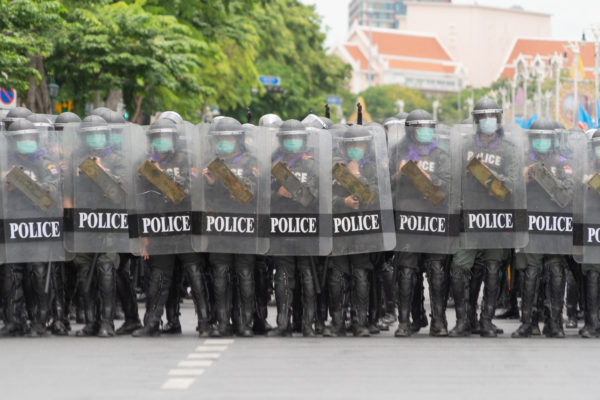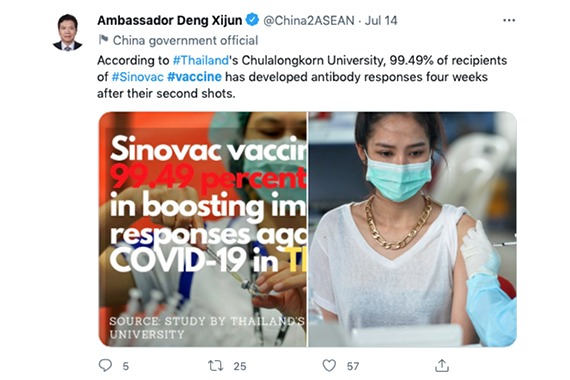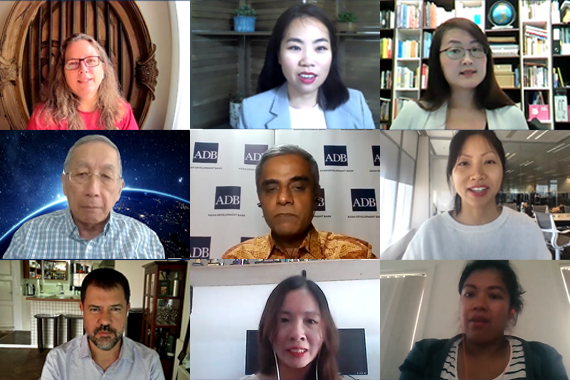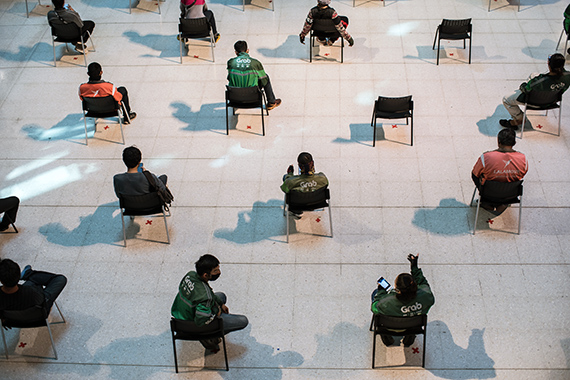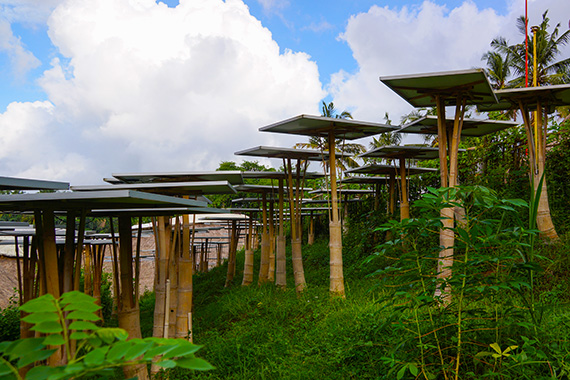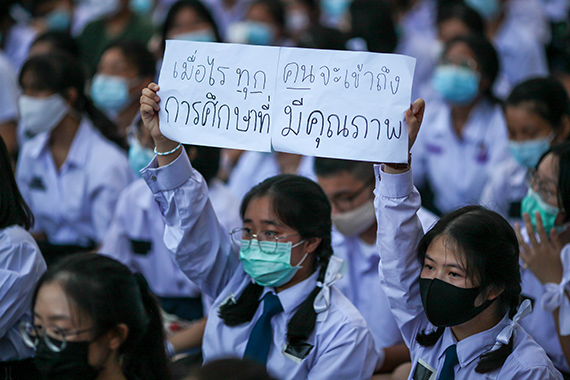Trading Out of Trouble – Southeast Asia’s Trade Prospects in a COVID-19 World
By Richard Maude
Published on 3rd February 2021
Read in 9 minutes
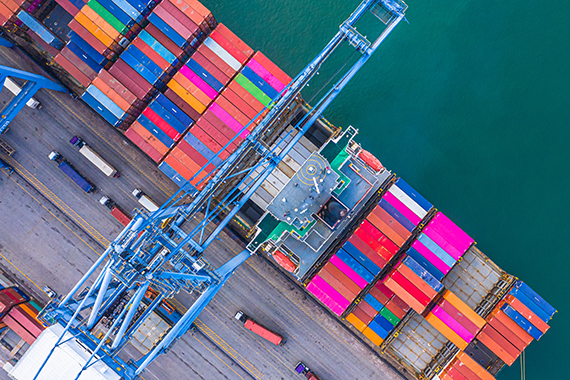
Container ship unloading – Avigator Fortuner – Shutterstock
Global trends in trade, foreign investment and production offer a mix of peril and opportunity for Southeast Asian governments as they try to steer their damaged economies towards recovery.
Beset by lockdowns, disrupted supply chains and travel restrictions, world trade volumes fell by historically steep levels in the first half of 2020.
Southeast Asia was no exception–the region’s economies rely heavily on external demand and many play increasingly significant roles in East Asian supply chains.
In the second quarter of 2020, for example, the value of goods exported from the ten members of the Association of Southeast Asian Nations (ASEAN) fell by 15 per cent on a year-on-year basis and imports fell by 27 per cent [1].
Aggregated data for services exports across 2020 is not yet available, but the shut down–virtually overnight–of Southeast Asia’s booming tourism industry wreaked immense economic damage. In Thailand, for example, tourism (international and domestic) accounts for some 20 per cent of GDP.
Foreign direct investment flows to Southeast Asia also declined sharply early in 2020. The United Nations Conference on Trade and Development (UNCTAD) expects the global slowdown in manufacturing to affect investment in Southeast Asia into 2021.
The vertiginous plunge in world goods trade, at least, may now be bottoming out, but the International Monetary Fund remains decidedly gloomy about prospects for a trade-led recovery in Asia, blaming weak global growth, closed borders and “festering tensions around trade, technology, and security”.
Even so, Southeast Asia has more than most to work with.
Skip to section:
East Asian economic regionalism will strengthen ASEAN can benefit from supply chain diversification Cloudy but fine? Interview About the AuthorEast Asian economic regionalism will strengthen
Trade within East Asia – much of it in integrated supply chains, where both intermediate and final products are traded – was growing strongly before the pandemic.
COVID-19 has put a big dent into this momentum. But Asia is well placed to bounce back better, and faster, than the region’s major external markets, notably the United States and Europe. That means more opportunity for trade between Asian economies.
Most major East Asian economies–China, Japan, the Republic of Korea and Taiwan–have managed to re-open their economies. China’s giant economy in particular is once again growing and helping keep Southeast Asian trade afloat.
Some Southeast Asian countries, for example, have already benefitted from robust demand from China for key exports, like integrated circuits, consumer electronics, palm oil and rubber.
Within Southeast Asia there are also signs the deep economic slump of the first half of 2020 is easing, at least in those parts of the region where the pandemic has been tamed. The decline in ASEAN global goods exports and imports, for example, slowed in the third quarter of 2020 on a quarter-on-quarter basis.
Vietnam, one of the best performing ASEAN economies, managed to eke out a small increase in economic growth in 2020, albeit the lowest growth figure for 30 years. Singapore and Malaysia did not fare so well, but the pace of GDP contraction in these economies slowed in the second half of 2020 on a year-on-year basis.
Job losses and concerns over future economic insecurity mean many Asian households are spending less. Still, over the medium-term, Asia’s growing consumer class will also continue to drive intra-regional trade.
This is no longer just a North Asian story. Bain and Company estimates that domestic consumption in Southeast Asia could double to $US4 trillion over the next ten years. This rising consumer class doesn’t just look to western brands: goods made and traded in Asia, like Chinese smartphones, are also on the shopping list.
Once it enters into force, the newly signed Regional Comprehensive Economic Partnership (RCEP) trade deal will give intra-Asian trading another boost.
RCEP includes nearly all the major Asian economies (India and Taiwan are exceptions). A common set of rules and standards will reduce transaction costs for businesses and make it easier to trade intermediate and final products within regional value chains. As Jeffrey Wilson notes, this is an incentive for large corporations to locate as much of their supply chains as possible within the bloc.
RCEP’s value to ASEAN would have been higher if India had stayed in the negotiation. The agreement’s accession clauses leave the door open for New Delhi, but there are no signs the Modi government will reconsider its decision any time soon. Indeed, a recent speech by India’s Minister for External Affairs, S. Jaishankar, is notable for its re-think on globalisation and (implicitly) ASEAN’s model of “open regionalism”.
America’s withdrawal from the Trans-Pacific Partnership negotiation was similarly costly for the four ASEAN countries who were parties to the deal. Singapore and Vietnam have since ratified the agreement, now called the Comprehensive and Progressive Agreement for Trans-Pacific Partnership (CPTPP). Brunei and Malaysia have not yet done so.
Having firmly ensconced itself within RCEP–by far the largest trade deal driving Asian economic regionalism–China now appears to be eying off CPTPP membership.
President Xi Jinping proclaims China wants to “hold high the banner of free trade and multilateralism”, but Beijing more likely sees a geo-political opportunity to further increase its role in regional trade and investment at the expense of the United States.
It’s far from clear how serious China is about joining the CPTPP, and whether it might seek major and contentious modifications to the agreement’s rules on issues such as state-owned enterprises, labour, investment, the environment, and intellectual property. The CPTPP’s current membership won’t want to trade too much of this away.
Nor is it clear if China’s apparent aspirations might lead the United States to reconsider membership. President Biden isn’t in a hurry to return to the CPTPP, and the United States will have its own set of negotiating demands when and if that moment arrives.
But there are alternatives that could be more politically-palatable stepping stones, such as an interim sectoral agreement on digital trade or medical products, as the Asia Society Policy Institute’s Wendy Cutler recently explored.
ASEAN can benefit from supply chain diversification
ASEAN is also well placed to benefit from supply chain diversification within East Asia.
Some manufacturing was already shifting to Southeast Asia before the pandemic, as companies sought to establish a “China plus one” model, including to escape higher labour costs in China and tariffs on Chinese imports imposed by the Trump Administration.
The pandemic has now reinforced interest from companies from around the world in regionalisation and supply chain diversification. Some governments want to encourage this. Japan, for example, is offering financial incentives to some of its companies to build production sites in Southeast Asia.

Bangkok Market – Lisheng Chang – Unsplash
With a favourable investment climate and a growing free trade agreement network, Vietnam has been a major beneficiary of the push for diversification out of China, including by Chinese companies themselves. Textiles, footwear and electronics are industries that have benefited.
As a result, Vietnamese imports of manufacturing inputs from China have risen over the past few years, and so too have exports of final products to both China and the United States.
Indeed, this trend has been so marked that Vietnam’s growing trade surplus with the United States attracted the attention of the Trump Administration, which imposed or threatened several trade remedies.
Amongst other issues, Washington has been concerned that Vietnam is allowing the trans-shipment of goods made in China but re-labelled to avoid tariffs. Still, the heavy-handed approach–especially an investigation into alleged currency manipulation–underlined the disconnect between the trade and regional security objectives of the Trump Administration.
The Carnegie Endowment’s Trinh Nguyen notes that Vietnam’s investment and manufacturing absorption capacity is limited by a labour force only 7 per cent the size of China’s. That will leave “more of the pie available to other economies” if they can improve their investment attractiveness.
Indonesia, for example, wants more foreign investment. President Widodo sees investment as one of the keys to future economic growth and his dream of Indonesia becoming an “advanced country” in 2045, the 100th anniversary of Indonesia’s independence. But his record on regulatory reform falls short of where Indonesia needs to be, and Jakarta’s latest omnibus law to remove red tape has become mired in controversy over its potential impact on workers.
Other Southeast Asian countries don’t have Indonesia’s labour supply or large domestic market. But some are also competing for a share of the diversification pie. A recent McKinsey study, for example, highlighted Thailand’s policies to establish an electric vehicle hub and Malaysia’s focus on solar-cell-module capacity.
Cloudy but fine?
Of course, as the IMF assessment above is clear, it won’t all be smooth sailing for Southeast Asia.
Subdued global demand will remain a drag on investment, manufacturing and trade.
China can’t fuel economic recovery in the way it did after the global financial crisis of 2007-08, when its economy was growing more quickly. The limits of China’s state-centred economic model are also increasingly apparent – high debt, unviable state-owned enterprises, costly failures in strategic priorities like the semi-conductor industry, and a reform program playing second fiddle to political control.
The outlook for US-China relations, including on trade and technology, remains highly uncertain. So too the approach of the Biden Administration to globalisation in general. These uncertainties raise risk for the region.
Biden is an internationalist, but his approach to economic policy and trade is likely to retain at least some of the economic nationalism of his predecessor. A big “buy American” pledge, for example, and other policies to support the US middle class, like encouraging re-shoring of some US manufacturing, were key election commitments.
More automation of manufacturing looms as a medium-term challenge. Not all industries are equally vulnerable, but some of Southeast Asia’s comparative advantages, especially labour costs, will be less marked as the sophistication of industrial robots improves and more factories are automated.
The region also needs more investment in infrastructure, especially to increase connectivity, and wider access to reliable, high-speed broadband internet and to 5G technologies.
Finally, Southeast Asia could also do more to facilitate trade within the region. ASEAN’s record of open regionalism is impressive, and intra-ASEAN trade in goods was a respectable 22.5 percent of total trade in 2019.
Still, this has declined from 24 percent in 2014. And the progressive dismantling of tariffs in Southeast Asia has been accompanied by a progressive increase in non-tariff measures, notwithstanding the creation of an ASEAN Economic Community Blueprint and the focus on stronger ASEAN economic cooperation and supply chain connectivity at last year’s ASEAN summits.
ASEAN is slowly working towards greater liberalisation of trade in services, but barriers are much higher than in goods trade. The movement of skilled workers generally remains tightly controlled. Finally, trade facilitation is also a work in progress, with important but incremental steps underway towards a region-wide single window for the digital exchange of trade-related documents.
Economic reform in Southeast is often as politically difficult as it is in many other parts of the world. The tangled mess of President Joko Widodo’s omnibus reform bill is a case in point. But the deep economic uncertainties brought by the pandemic and the emerging fourth industrial revolution make this a more urgent priority for the region.
Digital connectivity, building tech-ready human capital, investing in innovation, facilitating the flow of skilled labour and reducing barriers to cross-border flows of data and services are regularly cited as the types of policy reforms that will allow ASEAN countries to find opportunity in the future economy. Some Southeast Asian countries, such as Singapore and Malaysia, are leading ASEAN in these endeavours. Others, such as Indonesia, are lagging behind.
Like the rest of the world, Southeast Asia faces headwinds and uncertainties. The ability of the region’s countries to use trade to help drive economic recovery rests on global factors beyond their control as much as it does on their own commitment to keep reforming and improving their competitiveness.
Still, amid all the uncertainty and downside risk, Southeast Asia may yet find itself better placed than other regions to trade itself out of trouble.
Interview
About the Author
Richard Maude is Executive Director of Policy at Asia Society Australia and a Senior Fellow at the Asia Society Policy Institute. Mr. Maude joined Asia Society after a 30-year career as an Australian diplomat and intelligence official. He is a former Deputy Secretary of the Department of Foreign Affairs and Trade, Director-General of the Office of National Assessments, and senior foreign policy adviser to Prime Minister Julia Gillard.

